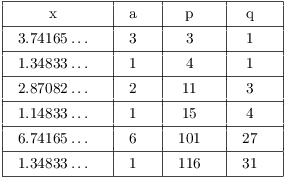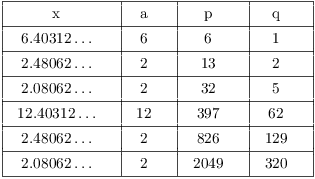Consider a Diophantine equation of the form
![]()
If d is a perfect square, you can solve the equation directly.
Example. Solve the Diophantine equation ![]() .
.
What about the equation ![]() ?
?
I can write the equation as
![]()
This is an equation in integers, and represents a factorization of
13. There are only two ways to factor 13 in positive integers: ![]() and
and ![]() . (You can check that
the negative factorizations give the same results.)
. (You can check that
the negative factorizations give the same results.)
Suppose ![]() and
and ![]() . This is
. This is
![]()
So
![]()
![]() is an integer solution,
so it qualifies as a solution to the original equation. Since x and y
appear as
is an integer solution,
so it qualifies as a solution to the original equation. Since x and y
appear as ![]() and
and ![]() in the original
equation,
in the original
equation, ![]() ,
, ![]() , and
, and ![]() also work.
also work.
Similarly, ![]() and
and ![]() give
give ![]() (which I
already know).
(which I
already know).
So the solutions to the Diophantine equation ![]() are
are ![]() ,
, ![]() ,
, ![]() , and
, and ![]() .
.
Now suppose I change the problem to ![]() . Write it as
. Write it as
![]()
The possible factorizations of 10 are ![]() ,
, ![]() ,
, ![]() , and
, and ![]() .
.
Try ![]() ,
, ![]() . Then
. Then
![$$\left[\matrix{ 1 & -3 \cr 1 & 3 \cr}\right] \left[\matrix{x \cr y \cr}\right] = \left[\matrix{1 \cr 10 \cr}\right], \quad\hbox{so}\quad \left[\matrix{x \cr y \cr}\right] = \dfrac{1}{6} \left[\matrix{ 3 & 3 \cr -1 & 1 \cr}\right] \left[\matrix{1 \cr 10 \cr}\right] = \left[\matrix{\dfrac{11}{2} \cr \noalign{\vskip2pt} \dfrac{3}{2} \cr}\right].$$](fermat-pell-equation33.png)
This is not a solution in integers, so this factorization gives no integer solutions.
You can verify that the other factorizations do not give integer
solutions. Hence, ![]() has no integer
solutions.
has no integer
solutions.![]()
Now consider the case where d is not a perfect square. The following
facts (which I'll state without proof) relate the solutions to ![]() to the continued fraction expansion of
to the continued fraction expansion of ![]() .
.
Theorem. Suppose ![]() , d is not a perfect square, and
, d is not a perfect square, and ![]() . Any positive solution of
. Any positive solution of ![]() with
with ![]() satisfies
satisfies ![]() ,
, ![]() for some
for some ![]() , where
, where ![]() is the
n-th convergent of the continued fraction expansion of
is the
n-th convergent of the continued fraction expansion of ![]() .
.![]()
The theorem doesn't say which convergent will give a
solution. The special form ![]() is
called the Fermat-Pell equation. In this case,
it's possible to say which convergent will solve the equation. I'll
state the following facts without proof, and give some examples.
is
called the Fermat-Pell equation. In this case,
it's possible to say which convergent will solve the equation. I'll
state the following facts without proof, and give some examples.
First, recall from the theory of periodic continued fractions that a
quadratic irrational --- in particular, a
number of the form ![]() , where d is not
a square --- has a periodic continued fraction expansion.
, where d is not
a square --- has a periodic continued fraction expansion.
Theorem. If ![]() and d is not a perfect square, then the continued
fraction expansion of
and d is not a perfect square, then the continued
fraction expansion of ![]() is periodic, and
has the form
is periodic, and
has the form
![]()
Theorem. Suppose ![]() and d is not a perfect square. Any positive solution
of
and d is not a perfect square. Any positive solution
of ![]() with
with ![]() satisfies
satisfies ![]() ,
, ![]() for some
for some ![]() , where
, where ![]() is the
n-th convergent of the continued fraction expansion of
is the
n-th convergent of the continued fraction expansion of ![]() .
.
Let t be the period of the expansion of ![]() .
.
(a) If t is even, then ![]() has no
solutions.
has no
solutions. ![]() has solutions
has solutions ![]() ,
, ![]() for
for ![]() .
.
(b) If t is odd, then ![]() has solutions
has solutions ![]() ,
, ![]() for
for ![]() , and
, and ![]() has
solutions
has
solutions ![]() ,
, ![]() for
for ![]() .
.![]()
Example. (a) Find the first 6 terms (![]() through
through ![]() ) and the numerators
and denominators of the first 6 convergents (
) and the numerators
and denominators of the first 6 convergents (![]() ,
, ![]() through
through ![]() ,
, ![]() ) of the continued fraction
expansion of
) of the continued fraction
expansion of ![]() .
.
(b) Use the continued fraction for ![]() to find solutions to the Fermat-Pell equations
to find solutions to the Fermat-Pell equations
![]()
(a)

(b) The expansion has period 4, which is even. Hence, ![]() has no solutions.
has no solutions.
The first solution to ![]() is
is ![]() . You can check
that
. You can check
that
![]()
Example. (a) Find the first 6 terms (![]() through
through ![]() ) and the numerators
and denominators of the first 6 convergents (
) and the numerators
and denominators of the first 6 convergents (![]() ,
, ![]() through
through ![]() ,
, ![]() ) of the continued fraction
expansion of
) of the continued fraction
expansion of ![]() .
.
(b) Use the continued fraction for ![]() to find solutions to the Fermat-Pell equations
to find solutions to the Fermat-Pell equations
![]()
(a)

(b) The period is 3, which is odd. The first solution to ![]() is given by
is given by ![]() . You can check
that
. You can check
that
![]()
For ![]() , I have
, I have ![]() , so the first solution is given by
, so the first solution is given by ![]() . You can check that
. You can check that
![]()
In fact, you can generate the solution to the second equation using
the solution to the first. Take ![]() , and compute
, and compute
![]()
The coefficients ![]() give the solution to the
second equation.
give the solution to the
second equation.
Here's an interesting example. The continued fraction expansion of
![]() is
is
![]()
![]()
It repeats after that.
The period is ![]() , so
, so ![]() has solutions of the form
has solutions of the form ![]() ,
, ![]() . Here's one:
. Here's one:
![]()
Copyright 2024 by Bruce Ikenaga